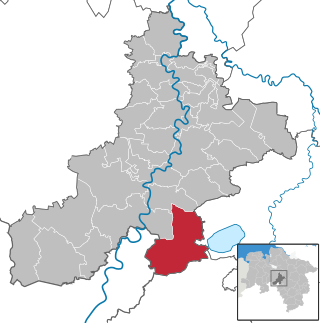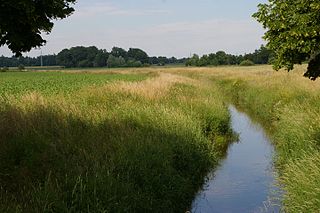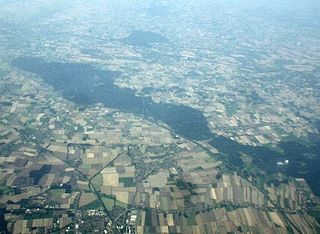The Middle Weser Region (German : Mittelweserregion) includes, in its fullest sense, the land along the Middle Weser between Minden and Bremen. It lies within the federal states of North Rhine-Westphalia, Lower Saxony and Bremen. However, the term is often used just to refer to the Lower Saxon part, because of the different political development of the three states and the cooperative associations formed in Lower Saxony some years ago (see below). The Lower Saxon part of the Middle Weser Region forms the geographical heart of this state. In the centre of the Middle Weser Region are the towns of Minden, Nienburg/Weser and Verden (Aller). In the extreme north, the city of Bremen, which is not part of Lower Saxony, has a very important influence on that area of Lower Saxony surrounding it.
For information about the Westphalian part of the Middle Weser Region see also Ostwestfalen-Lippe and Minden Land
The Middle Weser Region is part of the North German Plain. On either side of the Weser and its tributaries are broad marsh, geest (topography) and bog landscapes with original forests. Other parts of the region are used for agriculture. The southern part of the Middle Weser Region belongs to the Middle Weser Valley which is joined by the glacial valley of the Aller in the north.
Verden is a Kreis (district) in the centre of Lower Saxony, Germany. Adjoining it are the districts of Osterholz, Rotenburg, Heidekreis, Nienburg, and Diepholz, as well as the city of Bremen.
Nienburg is a district (Landkreis) in Lower Saxony, Germany. It is bounded by the districts of Diepholz, Verden, Heidekreis, Hanover and Schaumburg, and by the state of North Rhine-Westphalia.

Bouches-du-Weser was a department of the First French Empire in present-day Germany.

The County of Hoya was a state of the Holy Roman Empire, located in the present German state of Lower Saxony. It was centred on the town of Hoya on the middle Weser river, between Bremen and Nienburg; the area now belongs to the districts of Nienburg and Diepholz. The largest city in the county was Nienburg.

Rehburg-Loccum is a town 50 km north west of Hanover in the district of Nienburg in Lower Saxony, Germany.

Bruchhausen-Vilsen is a municipality in the Diepholz district, in Lower Saxony, Germany. It is situated 38 km (24 mi) southeast of Bremen. The nearby communities of Berxen, Bruchhöfen, Bruchmühlen, Dille, Gehlbergen, Heiligenberg, Homfeld, Nenndorf, Riethausen, Stapelshorn, Wöpse, Oerdinghausen, Scholen, Weseloh, Süstedt and Engeln all belong to Bruchhausen-Vilsen. Bruchhausen-Vilsen is also the seat of the Samtgemeinde Bruchhausen-Vilsen.

Eystrup is a municipality in the district of Nienburg, in Lower Saxony, Germany. It is situated on the right bank of the Weser, approx. 15 km north of Nienburg, and 15 km south of Verden. Eystrup was the seat of the former Samtgemeinde Eystrup.

Hoya is a town in the District of Nienburg, in Lower Saxony, Germany. It is situated on the left and right bank of the Weser, approx. 20 km north of Nienburg, and 15 km southwest of Verden.

Marklohe is a municipality in Lower Saxony, Germany.
Grafschaft Hoya is a Samtgemeinde in the district of Nienburg, in Lower Saxony, Germany. Its seat is in the town Hoya. Its name refers to the medieval County of Hoya. On 1 January 2011, it merged with the former Samtgemeinde Eystrup.

Duddenhausen is a village in the municipality of Bücken, district of Nienburg, in Lower Saxony, Germany. Duddenhausen has an area of 705 hectares.

The Middle Weser Valley is part of the Weser Depression around the River Weser on the North German Plain, extending from the gap of Porta Westfalica to the town of Hoya. It is not a true valley, because it is only bordered by low hills at two points. It lies in the German federal states of Lower Saxony and North Rhine-Westphalia.

Siede is a river of Lower Saxony, Germany. It is a left-hand (northern) tributary of the Große Aue, about 25 kilometres (16 mi) long. It runs mainly through the southern part of the district of Diepholz and belongs to the Weser river system.

The Weser Depression or Weser Lowlands is the region north of Porta Westfalica in Germany, where the River Weser no longer flows through a valley, but a broad plain consisting of meadows and river terraces.

The Lower Saxon Asparagus Road is a tourist route in North Germany that confers recognition of the asparagus as a delicacy in the region. The vegetable is grown in the areas between Brunswick and Lüneburg, between Bremen, Cloppenburg and Vechta, and from Nienburg/Weser via Hoya to Soltau.
The Rahden-Diepenau Geest is a natural region in the extreme northeast of North Rhine-Westphalia and in the neighbouring state of Lower Saxony in north Germany. It includes the overwhelmingly gently rolling geest between the Lübbecker Lößland to the south, the Diepholz Moor Depression to the north, the Middle Weser Valley to the east and the western Wiehen Hills and Bersenbrück Land to the west. The Rahden-Diepenau Geest is part of the Dümmer Geest Depression and thus belongs to the North German Plain, although they include foothills of the Central Uplands in the shape of the Stemmer Berge.

The Wunstorf–Bremen railway line is one of the most important lines in the German state of Lower Saxony. It connects the port city of Bremen via Verden an der Aller and Nienburg to Wunstorf, where it connects with the line to Hanover. The 122.3-kilometre-long (76.0 mi), twin-track main line is continuously electrified. The maximum speed is 160 kilometres per hour (99 mph), the maximum axle load is 22.5 tonnes (50,000 lb) and the line is rated as class D4 in the German system of track classification. It was opened on in 1847.

The Verden–Rotenburg railway is a single-track mainline in the German state of Lower Saxony, which connects Verden (Aller) station on the Wunstorf–Bremen railway with Rotenburg station on the Wanne-Eickel–Hamburg railway.

The Schaumburg Forest is a wooded region, about 80 m above sea level (NN) with an area of around 40 km², in the district of Schaumburg in the German federal state of Lower Saxony.

Verden (Aller) or Verden an der Aller (German: Bahnhof Verden (Aller)) is a railway station located in Verden an der Aller, Germany. The station was opened in 1847 and is located on the Bremen–Hanover railway and Rotenburg-Verden railway. The train services are operated by Deutsche Bahn and NordWestBahn. The station has been part of the Bremen S-Bahn since December 2010.